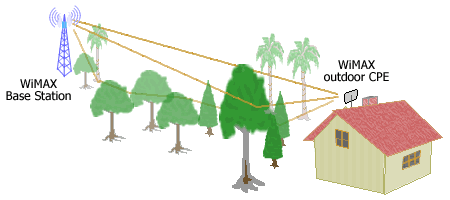LOS versus NLOS
Line-of-sight (LOS) is a condition where a signal travels over the air
directly from a wireless transmitter to a wireless receiver without passing
an obstruction. LOS is an ideal condition for a wireless transmission
because the propagation challenge only comes from weather or atmospheric
parameters and the characteristic of its operating frequency. In LOS
environment, signal can
reach longer distance with better signal strength and
higher throughput.
Conversely, non-line-of-sight (NLOS) is a condition where a
signal from a wireless transmitter passes several obstructions before arriving
at a wireless receiver. The signal may be reflected, refracted, diffracted,
absorbed or scattered. These create multiple signals that will arrive at a
receiver at different times, from different paths, and with different
strength. Consequently, wireless systems developed for NLOS environment have to incorporate
a number of techniques to overcome this problem and that make the systems
more complex than those for LOS. But NLOS capable systems simplify network
planning and site acquisition.

Picture. Multipath in NLOS environment
Signal travels thru multiple paths. Multiple reflected signals hit
a receiver.
WiMAX offers operators the solution to address many applications with its
outstanding performance in NLOS environment. WiMAX is built on the robust
OFDM/OFDMA physical layer (PHY) which can work with larger delay spread
typical in NLOS environment. It can easily overcome frequency selective fading by equalizing at sub-carrier
level. And its long symbol period (due to its use of parallel sub-carriers)
will eliminate the ISI (inter symbol interference).
A number of advanced techniques such as subchannelization, adaptive
modulation and coding (AMC), AAS and
MIMO are also incorporated into WiMAX
to make it even perform better in NLOS environment. Subchannelization allows
WiMAX to concentrate transmit power on sub-channel(s), increasing the reach
of a signal. AMC in both downlink and uplink enables WiMAX to
adjust modulation and code rate dynamically based on each sub-channel
condition and data rate requirement. AAS can focus the WiMAX Base Station
sector beam to the direction of a user device. And MIMO can improve signal
strength and throughput significantly with every additional antenna at the
BS and the SS. Those techniques can collectively improve WiMAX performance
and coverage in areas with difficult terrain (hilly), many obstructions
(buildings and trees), or inside a building.
|